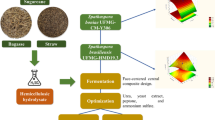Abstract
Worldwide, 9600 t of agar is produced annually. Meanwhile, 60% of the waste produced from the agar industry yearly do not get treated. Our present study aims to study the enzymatic saccharification of solid agar waste produced from two of the most widely used agarophytes in the agar industry, Gracilaria verrucosa and Gelidium latifolium. Gracilaria species are the most common raw material in the food grade agar industry, while Gelidium species are the most common raw material used for bacteriological and pharmaceutical purposes because of the high-quality agar that is produced from these species. Our results showed that waste generated from agar extraction still contained sugars which could be optimized by acid pretreatment and enzymatic saccharification. Gracilaria verrucosa resulted in a higher agar yield (35.15 ± 1.17%), but produced less agar waste (20.91 ± 0.43%) than G. latifolium. After sequential acid pretreatment and enzymatic saccharification of the agar waste, the agar waste hydrolysate of G. latifolium resulted in higher glucose, galactose, and ethanol production, and a higher ethanol yield (18.17 ± 0.75, 16.17 ± 2.07, and 10.83 ± 0.30 g L−1 and 0.33 g g−1, respectively) than G. verrucosa. The results from our present study may be used to optimize biorefinery utilization of G. verrucosa and G. latifolium.








Similar content being viewed by others
References
Adams JM, Gallagher JA, Donnison IS (2009) Fermentation study on Saccharina latissima for bioethanol production considering variable pre-treatments. J Appl Phycol 21:569–574
Alvira P, Tomás-Pejó E, Ballesteros M, Negro MJ (2010) Pretreatment technologies for an efficient bioethanol production process based on enzymatic hydrolysis: a review. Bioresour Technol 101:4851–4861
Arvizu-Higuera DL, Rodríguez-Montesinos YE, Murillo-Álvarez JI, Muñoz-Ochoa M, Hernández-Carmona G (2008) Effect of alkali treatment time and extraction time on agar from Gracilaria vermiculophylla. J Appl Phycol 20:515–519
Bixler HJ, Porse H (2011) A decade of change in the seaweed hydrocolloids industry. J Appl Phycol 23:321–335
Choi D, Sim HS, Piao YL, Ying W, Cho H (2009) Sugar production from raw seaweed using the enzyme method. J Ind Eng Chem 15:12–15
Freile-Pelegrín Y, Robledo DR, García-Reina G (1995) Seasonal agar yield and quality in Gelidium canariensis (Grunow) Seoane-Camba (Gelidiales, Rhodophyta) from Gran Canaria, Spain. J Appl Phycol 7:141–144
Hong IK, Jeon H, Lee SB (2014) Comparison of red, brown and green seaweeds on enzymatic saccharification process. J Ind Eng Chem 20:2687–2691
Lemus A, Bird K, Kapraun DF, Koehn F (1991) Agar yield, quality and standing crop biomass of Gelidium serrulatum, Gelidium floridanum and Pterocladia capillacea in Venezuela. Food Hydrocoll 5:469–479
Marinho-Soriano E (2001) Agar polysaccharides from Gracilaria species (Rhodophyta, Gracilariaceae). J Biotechnol 89:81–84
McHugh DJ (1991) Worldwide distribution of commercial resources of seaweeds including Gelidium. Hydrobiologia 221:19–29
McHugh DJ (2003) A guide to the seaweed industry. Fisheries Technical Paper, FAO, Rome
Meinita MDN, Hong YK, Jeong GT (2012) Comparison of sulfuric and hydrochloric acids as catalysts in hydrolysis of Kappaphycus alvarezii (cottonii). Bioprocess Biosyst Eng 35:123–128
Meinita MDN, Marhaeni B, Winanto T, et al (2015) Catalytic efficiency of sulfuric and hydrochloric acids for the hydrolysis of Gelidium latifolium (Gelidiales, Rhodophyta) in bioethanol production. J Ind Eng Chem 27:108–114
Meinita MDN, Marhaeni B, Winanto T, Jeong GT, Khan MNA, Hong YK (2013) Comparison of agarophytes (Gelidium, Gracilaria, and Gracilariopsis) as potential resources for bioethanol production. J Appl Phycol 25:1957–1961
Mollet JC, Rahaoui A, Lemoine Y (1998) Yield, chemical composition and gel strength of agarocolloids of Gracilaria gracilis, Gracilariopsis longissima and the newly reported Gracilaria cf. vermiculophylla from Roscoff (Brittany, France). J Appl Phycol 10:59–66
Mouradi-Givernaud A, Givernaud T, Morvan H, Cosson J (1993) Annual variations of the biochemical composition of Gelidium latifolium (Greville) Thuret et Bornet. Hydrobiologia 260/261:607–612
Murano E (1995) Chemical structure and quality of agars from Gracilaria. J Appl Phycol 7:245–254
Pambudi LT, Dyah M, Meinita N, Ariyati RW (2010) Seaweed cultivation in Indonesia: recent status. Mar Biosci Biotech 4:6–10
Park JH, Hong JY, Jang HC, Oh SG, Kim SH, Yoon JJ, Kim YJ (2012) Use of Gelidium amansii as a promising resource for bioethanol: a practical approach for continuous dilute-acid hydrolysis and fermentation. Bioresour Technol 108:83–88
Porse H, Rudolph B (2017) The seaweed hydrocolloid industry: 2016 updates, requirements, and outlook. J Appl Phycol. doi:10.1007/s10811-017-1144-0
Rebello J, Ohno M, Ukeda H, Sawamura M (1996) Agar quality of commercial agarophytes from different geographical origins: 1. Physical and rheological properties. J Appl Phycol 8:517–521
Rebello J, Ohno M, Ukeda H, Kusunose H, Sawamura M (1997) 3,6-Anhydrogalactose, sulfate and methoxyl contents of commercial agarophytes from different geographical origins. J Appl Phycol 9:367–370
Vergara-Rodarte MA, Hernández-Carmona G, Rodríguez-Montesinos YE, Arvizu-Higuera DL, Riosmena-Rodríguez R, Murillo-Álvarez JI (2010) Seasonal variation of agar from Gracilaria vermiculophylla, effect of alkali treatment time, and stability of its Colagar. J Appl Phycol 22:753–759
Wu FC, Wu JY, Liao YJ, Wang MY, Shih IL (2014) Sequential acid and enzymatic hydrolysis in situ and bioethanol production from Gracilaria biomass. Bioresour Technol 156:123–131
Acknowledgments
The Ministry of Research, Technology, and Higher Education of Republic of Indonesia supported this work. We thank the Biotechnology Department at Pukyong National University for their collaboration.
Author information
Authors and Affiliations
Corresponding author
Rights and permissions
About this article
Cite this article
Meinita, M.D.N., Marhaeni, B., Hong, YK. et al. Enzymatic saccharification of agar waste from Gracilaria verrucosa and Gelidium latifolium for bioethanol production. J Appl Phycol 29, 3201–3209 (2017). https://doi.org/10.1007/s10811-017-1205-4
Received:
Revised:
Accepted:
Published:
Issue Date:
DOI: https://doi.org/10.1007/s10811-017-1205-4




